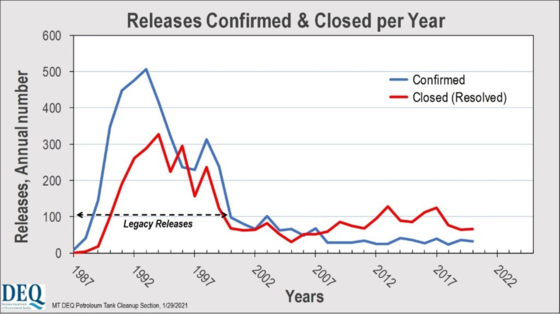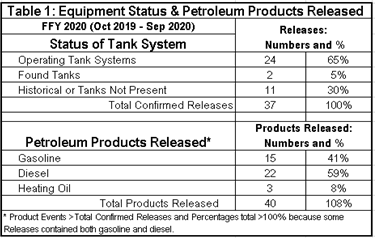
New Deadlines for Montana UST Rules
Better early than later. Get a jump start on upcoming Montana UST Rules deadlines. Starting early will give you the advantage to work out any bugs and give you time to ask the UST Section any questions that may arise before looming deadlines. Starting early also gives you time to figure out an efficient process, set a schedule, and helps it become routine. Here is what is new and must be completed no later than October 13, 2021:
Walkthrough Inspections
-
Owners/Operators must conduct monthly walkthrough inspections to prevent and quickly detect releases.
-
The following equipment requires inspection:
1. Spill buckets and fill pipes: Every 30 days
2. Release detection equipment and records: Every 30 days
3. Containment Sumps: Annually
- The inspections may be completed using DEQ’s Walkthrough Inspection Form or PEI RP 900, which is available for purchase.
-
Inspections may be performed by: Owners, Operators, Class A, B, C Operators or 3rd party contractors
Annual Testing and Inspection
-
Must be performed by a Montana UST Program licensee.
-
Primary release detection equipment must pass an annual functionality test. The following equipment must be tested:
-
Automatic tank gauges & probes
-
Electronic and mechanical line leak detectors
-
Interstitial tank & piping monitoring sensors
3-Year Testing and Inspection
-
Must be performed by a Montana UST Program licensee.
-
Owners/Operators of regulated UST systems must test spill buckets and overfill prevention equipment every 3 years. First test must be completed no later than October 13, 2021.
-
Spill buckets: must pass a tightness test every 3 years. Double wall spill buckets with 30- day interstitial monitoring records may be used in lieu of performing a tightness test.
-
Overfill devices: must be inspected for functionality every 3 years.
- Automatic shut-off devices (i.e. flapper valve, auto limiter) - 95% activation level
-
Audio/Visual alarm via float sensor - 90% activation level
-
Ball float vent valve* - 90% activation level (ball float valves not allowed for new installations)
-
Containment sumps: All containment sumps using interstitial monitoring as their primary line leak detection method must be hydrostatically tested** every three years. This includes all UST systems installed, modified, or replaced after November 26, 2009 (includes piping replacements) as well as systems that use interstitial monitoring as their primary piping leak detection method.
*Please note that ball floats that have been paved over must be inspected. If a ball float fails an overfill inspection it cannot be replaced and another approved device must be installed.
**Other methods may be used. Contact the UST Program for details.
No longer allowed after October 13, 2023
-
Out-of-Tank Leak Detection o Groundwater Monitoring and Vapor Monitoring, as a leak detection method, will no longer be allowed after October 13, 2023.
Resources & Forms
If you have any questions please contact Montana DEQ’s UST program at (406) 444-5300 or email DEQUSTPROGRAM@mt.gov
|

Petroleum Release Reporting Requirements and Tank System Upgrades
Petroleum-contaminated soil is often encountered during removal and upgrades to petroleum tank systems and can be costly to the facility owner if not reported at the time of discovery. As DEQ prepares for an abundance of spill bucket upgrades it is a good time to review release and suspect release reporting rule requirements found at ARM 17.56.501 through 508.
A suspect release needs to be reported to DEQ immediately within 24-hours of encountering petroleum-contaminated and/or petroleum-stained soil that was identified through visual or olfactory means. Failure to report a release or suspect release within 24-hours has resulted in a penalty reduction from the Petroleum Tank Release Compensation Fund (PTRCF). If DEQ requires additional investigation and remediation, this penalty can cost facility owners a great deal of money out-of-pocket.
Often a suspect release is confirmed by laboratory analytical results from soil samples that were collected during the petroleum tank system removal or upgrade and are later reported to DEQ. Unfortunately, if the installer/remover indicates that they had visual or olfactory knowledge of the suspected petroleum contamination prior to receiving the laboratory analytical results of the soil samples, the report is considered outside of the 24-hour reporting period. If you see it and/or smell it, report it!
If you report a suspected petroleum release to DEQ during a petroleum-tank system removal or upgrade, DEQ will determine if a petroleum release has occurred based on the laboratory analytical results once they are received. DEQ can resolve the suspected petroleum release with no further implications to the responsible party if DEQ’s risk-based screening levels are not exceeded. If you are unsure about reporting suspected petroleum releases, contact the Petroleum Tank Cleanup Section and speak with a project officer who can further assist you.
Montana DEQ Spill Management and Reporting Policy
|
Closures of petroleum releases exceed confirmations of new releases 2008 - 2020
DEQ’s Petroleum Tank Cleanup Section confirmed 37 new petroleum releases during federal fiscal year (FFY) 2020 (October 2019 - September 2020). This number is above the average number of 32 new releases per year since 2008. However, as illustrated in Figure 1 below, the number of new releases confirmed each year had little fluctuation during the last 12 years (2008 – 2020). No upward or downward trend is apparent in these recent data.
 Figure 1. Number of new releases confirmed and closed each year from 1987 through 2020.
Legacy petroleum releases – confirmed from 1987 thru 1999 during Federally-required upgrades to underground storage tanks – greatly exceed the number of releases confirmed since 2000, both in confirmations and closures as illustrated in Figure 2 below. While only 17% of legacy releases remain open, those 644 releases comprise 69% of DEQ’s remaining open releases. A total of 3,310 legacy releases have been closed; 2,230 of these were closed before the end of 1999; and the other 1,080 were closed between 2000 and 2020.
Closures of DEQ’s petroleum-tank releases demonstrate an upward trendline beginning in 2005 as illustrated in Figure 1 above. Closures of legacy releases have averaged 51% of total annual closures since 2005.
Un-resolved legacy releases continue to represent an opportunity for the greatest number of future remedial investigations, cleanup work, and compliance monitoring projects. Legacy releases also represent significant challenges due to site-specific conditions that typically limit access for petroleum-source removal; often reduce rates of natural attenuation; and limit remediation pathways to closure.
 Figure 2. Legacy petroleum releases (confirmed 1987 – 1999) greatly exceed number of releases confirmed since 2000, both in confirmations and closures.
Source & Cause of Petroleum Releases in 2020
There were a total of 37 State and federally regulated petroleum releases confirmed during FFY 2020. Table 1 shows the number and type of products released in 2020; these are similar to releases observed in previous years, with diesel and gasoline comprising most of the product released and heating oil as the third most common product released. In previous years, waste oil, hydraulic fluid, jet fuel, aviation gasoline, turbine oil, fuel additives, and a few other substances have been released as well.
 Table 1. Fuel types released in FFY 2020. The product released number (40) is more than the number of releases (37) because three releases contained two product types.
The source of the 37 releases is broken out into ten categories as shown in Table 2. Three of the categories include general parts of the tank systems: tanks, their connected pumps and piping, and the dispenser islands. Delivery problems indicate releases associated with fuel tankers delivering product to a facility. The fifth category, historic contamination, means that the releases originated from historic (pre-1998) tank systems.
 Table 2. Summary of sources & causes of petroleum releases confirmed in FFY 2020.
While the source of the release pertains to the part of a fuel system from which a release occurred, the cause of the release indicates what went wrong. Looking at the sources of the 37 new releases confirmed in 2020, we can see that only three releases were attributed to pre-1998 tank systems. However, when we look at what went wrong, 17 releases were caused by historic or other activities that cannot be precisely identified and therefore are not discussed further. The 20 remaining releases definitively caused in 2020 can be attributed to three causes: physical damage to tank systems, tank equipment failure, and human error.
One important takeaway from this data is that human error is the largest cause of new releases. Please ensure that operators and attendants are ready to respond to spills. Below are some other reminders based on previous years’ lessons learned:
-
Equipment wears out from age and normal wear and tear.
- Ensure that your leak detection equipment is functioning properly, is tested per regulations, and that you address any alarms immediately.
-
Install and test liquid-tight secondary containment associated with piping, submersible turbine pumps, dispensers, and other system parts.
-
Functional parts of your system, such as dispenser hoses, may not be monitored by your line leak detectors.
-
Ask your equipment installer or inspector if yours are monitored.
-
Consider upgrading your UST systems to secondarily contained piping and tanks.
-
Suspected petroleum releases must be reported to DEQ within 24 hours of discovery.
-
DEQ’s petroleum release reporting hotline may be reached at (800) 457-0568. After hours and on weekends, releases must be reported by calling the Disaster and Emergency Services duty officer at (406) 324-4777. For more information on release reporting, please see DEQ’s website: http://deq.mt.gov/Land/lust/faqs
-
Do not risk an ongoing leak.
-
Do not jeopardize your Petroleum Tank Release Compensation Fund reimbursement by failing to properly report releases and suspect releases.
|